Applied Conservation Lab
Past Research Projects (click on project titles for poster)
Applied Conservation Lab Homepage
The introduction of invasive species is one of the main threats causing native wildlife to become threatened and endangered in the United States (US). The purpose of this research project is to identify which invasive species are the most prevalent in causing species endangerment, how invasive species impact native species and where do invasive species originate from. Our goal is to develop policy and biological control guidelines for the National Invasive Species Council in controlling and mitigating the spread of invasive species to benefit native species of wildlife in the US.
We tested unique camera-trapping devices (MouseCams) for biological surveys of small terrestrial mammals to determine species presence. Our goal was to determine if MouseCams can be used to detect small mammal species of conservation concern. They proved to be effective.

Documenting Success: Recovery of Species From The Endangered Species Act
The goal of our analysis was to identify strategies that can reduce conflict between species conservation and economic growth. Recommended strategies include expediting the listing process for unprotected at risk species to expedite future recovery potential, provide economic incentives to working private landowners who manage for federally listed species, and have states and federal agencies work more closely to establish agreements and assurances in managing at risk and federally protected species. These recommendations help establish scientifically based bipartisan efforts to reduce the need for federal listing and expedite species recovery under the ESA.
Radio-Tracking Ring-necked Pheasants (Wildlife Ecology & Management Class)
Research can allow students to apply traditional course content into applied problem-solving. The implementation of research projects as a teaching model for STEM courses may increase student retention in STEM academic programs. With the help of undergraduate research students, a field research project involving radio tracking of ring-necked pheasants (Phasianus colchicus) is being conducted on the Millersville campus. Ring-necked pheasants have been an important economic game bird species since their introduction to the United States from Asia. They have also been used to help determine conservation reserve success in agricultural areas, such as Lancaster County Pennsylvania. During this course, 5 ring-necked pheasants were released at the Millersville campus. These birds are being tracked for 2 months using VHF radio-telemetry. Tentative home range size, habitat use and mortality rates of the pheasants will be analyzed. The tracking of ring-necked pheasants has been found to be a good model to bring the research experience into the classroom to expand a student’s skill set in field biology and increase their interest in ecology.
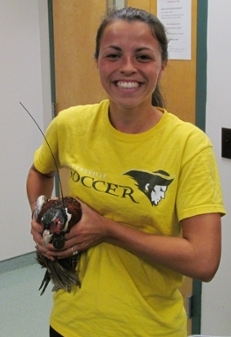
The United States (US) Endangered Species Act (ESA) prevents species extinction; however, the number of recovered species lags far behind the number of species still listed. Hotspot analysis is a simple way to identify important areas for conservation of rare species. Jenkins et al. (2015) identified priority areas in the US for the protection of endemic species (Figure 1A). To improve recovery efforts for the ESA, our objective was to identify hotspots for threatened and endangered (i.e., rare) animal species impacted by specific threats. By identifying these threat hotspots, we can determine where in the US specific conservation strategies are needed to mitigate biodiversity loss (Haines et al. 2012).
Temporal Analysis of Threats Causing Species Endangerment in the United States (Undergraduate Researchers: Delaney Costante, Alex Sandercock and Kayli Thomas)
Understanding temporal variation of threats that cause species endangerment is a key to understand onservation strategies needed to improve species recovery. We assessed temporal variation in the threats to species listed under the United States Endangered Species Act (ESA) as identified by the United States Fish and Wildlife Service (USFWS) and National Marine Fisheries Service (NMFS). We screened listing decision documents to determine threat occurrence (i.e., presence/absence of a given threat in a listing decision) for each threat category for all species listed between 1975 and 2017. We evaluated how the number of threats and specific threat occurrences changed over the past four decades. We found that the number of threats per listing decision increased more than twofold from an average of 1.5 (95% CI: 1.3–1.7) threats in 1975 to 3.7 (95% CI:3.4–4.0) threats in 2017. Threat occurrence increased for habitat modification, environmental stochasticity and species–species interaction, while it decreased for overutilization since 1975 and for demographic stochasticity and pollution since the mid-2000s. The documented increase in number of threats at time of listing may be due to a growing human population exerting increased pressure on species persistence, improved scientific advancement in understanding factors influencing species endangerment, or prolonged time taken for more recent species to be listed under the ESA. We believe that key federal and state governmental regulations have resulted in a documented decrease in overutilization, demographic stochasticity, and pollution, and we recommend large-scale strategies combined with local planning efforts to address the growing threats of habitat loss, environmental stochasticity, and species–species interaction.
Evaluating the Effectiveness of an Animal Hair Dye Marker for Marking Small Mammals in Field Research (Undergraduate Researchers: Tyler Bridgehouse and Grace Nussbaum)
The capture-recapture of wildlife is used to provide estimates of population density, survival, recruitment and movement. This information is important for guiding conservation management decisions. Capture-recapture involves placing an identifiable marker on a captured individual. Our objective was to test the effectiveness of small mammal identifiable markers. Ear-tag marking has been used successfully on small mammals, but can inhibit grooming and promote infection. For short-term studies, non-toxic hair-dyes may be less invasive. We used three different marking techniques (ear-tagging, Clairol hair-dye and The Muromachi Kikai hair-dye marker) on Peromyscus leucopus. This study was conducted at Millersville University and consisted of two transect lines, each with ten Sherman traps checked twice weekly. Data for different marking techniques were photo recorded to validate effectiveness. Tentative results suggest that the Muromachi Kikai hair-dye marker outlasts the Clairol hair-dye and can be used to distinguish individuals after two weeks in the field.
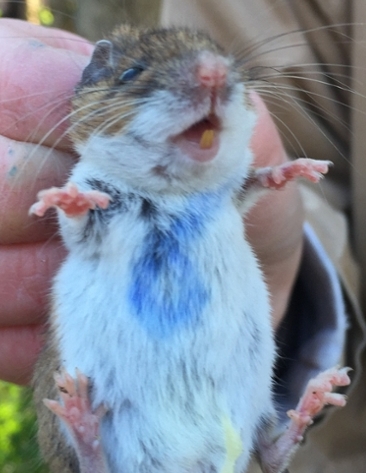
The Northern short-tailed shrew (Blarina brevicauda), is a solitary and territorial mammal that commonly preys on terrestrial invertebrates, but is also known to eat vertebrates such as rodents and frogs. Our objective will be to determine if the Northern short-tailed shrew becomes more attracted to rodent urine when invertebrate numbers decline during colder temperatures. Our study will occur over 2 years, the first year on two field sites on the Millersville University Biological Preserve and the second on two Lancaster County Conservancy Properties. Each field site will contain a trap line consisting of paired Sherman small mammal traps (treatment and control). Trapping success will be recorded as the number of shrew captures recorded on each trap line for both control and treatment traps divided by the total number of traps. To sample for invertebrate prey abundance, four 24cm2 areas of subfolium and topsoil will be sampled at each trapline. At each of the invertebrate sampling sites, ambient, subfolium, and soil temperatures will be recorded. We will use a general linearized model to determine if trapping success was influenced by invertebrate prey abundance, ambient temperature, subfolium temperature and topsoil temperature. This study will provide a greater ecological understanding of potential prey switching strategies of the Northern short-tailed shrew.
Millersville University An Official Hawk Watch Site (Undergraduate Hawk Watchers: Halie Parker, Jen Houtz, Rachel Davies, Rochelle Jones and Keven Faccenda)
The Millersville University Biology Department and Meteorology Program began a joint project of a hawk watch count on the Millersville University campus in collaboration with Dr. Laurie Goodrich, Raptor Biologist with the Hawk Mountain Observatory (http://www.hawkmountain.org/). Hawk count sites have been collecting data on migrating hawks for years. They use long-term migration databases to monitor changes in raptor (i.e., hawks, eagles, osprey, vultures and falcons) populations. Monitoring raptor populations are important because raptors are sensitive bioindicators at the top of food chains, and changes in the numbers of raptors reflect changes in the health of the environment. All student count data is uploaded to a national database at, www.hawkcount.org. In addition, results are recorded on the Trektellen international bird migration count database, http://www.trektellen.nl/?language=english&.
The real exciting news is that Millersville University students can keep track of these raptors as they fly over campus in real time. The Millersville University Hawk Count project can be found on the Dunkadoo webpage, https://dunkadoo.org/explore/millersville-university-applied-conservations/millersville-hawk-count-fall-2017. By following the link to this project, all students can see what birds of prey have flown over campus, up to the minute, and be able to see hawk count statistics gathered on campus.
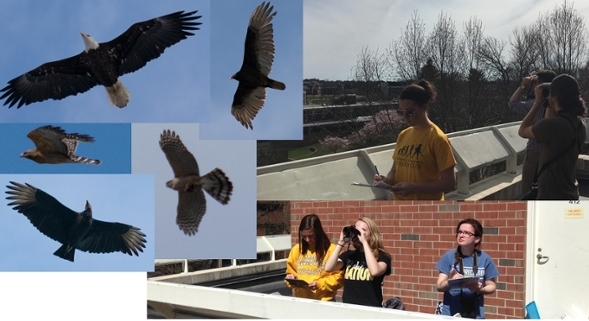
Identification of Research Needs for Wildlife Law Enforcement (Undergraduate Researcher Folake Meshe)
Wildlife law enforcement has been a tool used to conserve and protect species threatened by negative anthropogenic effects since the early 1200’s in England, and continues to be implemented in a number of different societies today. Wildlife law enforcement is just as important as biological research and management when speaking of wildlife preservation, but is not treated as such in the research community. A survey pinpointing areas of needed wildlife research was sent out to various wildlife law enforcement agencies in the United States. Identifying the research needs of wildlife law enforcement officers will help us better understand how to enforce rules and improve laws to apprehend and detain wildlife violators. Survey results are currently being compiled and analyzed. It was hypothesized that the survey results will express a huge need in research for multiple, if not every, wildlife agency contacted. Information revealed from the survey results will be used to promote wildlife law enforcement research needs.
Soil Testing To Identify Illegal Bait Sites for Wildlife (Undergraduate Researchers Angela Fetterolf, Meta Griffin, and Tristan Conrad)
Supplemental feeding and baiting of wildlife has the potential to increase the spread of diseases such as Chronic Wasting Disease. Also, the baiting of wildlife for harvest is illegal in many areas. The objective of this study was to determine if commercial wildlife baits leave a chemical signature in the soil which is detectable through chemical analysis. This information could be used by wildlife officers to determine if an area was illegally baited. Commercial wildlife baits were applied to experimental soil patches and compared to non-baited soil patches. The commercial baits that were used in this experiment included ‘3 Day Harvest’ by C’Mere Deer®, ‘Acorn Rage JUICED’ by Wildgame Innovations, and ‘Deer Cane’ mix by Evolved Habitats Wildlife Nutritional Products®. It was hypothesized that baited areas would exhibit higher concentrations of calcium, sodium, and chloride compared to non-baited soil. Atomic absorption spectroscopy was used to measure the amount of sodium and calcium ions and a chloride probe was used to measure chloride ions. Results of this experiment show that for both ‘Deer Cane’ and ‘Acorn Rage JUICED’ the presence of both Sodium and Chloride ions were adequate indicators of baiting activity. However, further studies are needed to find less expensive ways of testing for these chemical ions so that wildlife officers can easily determine if a site has been baited illegally.
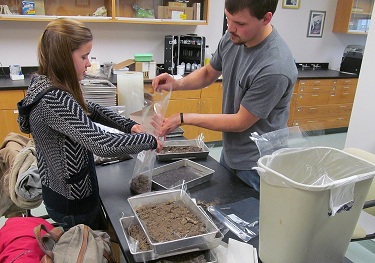
Surveying for Winter Birds Using Remote Devices and Automated Software (Undergraduate Researcher Andrew Wolfgang)
Avian researchers have been experimenting with technology which allows surveying to occur without wasting long hours in the field. Automated recording devices can survey long time periods at predetermined time intervals. This means that personnel are not deployed for a costly length of time. In addition, claims have been made that new survey software can automatically detect bird species based on their call or song. In this project, Andrew Wolfgang chose to analyze computerized identification technology available from Wildlife Acoustics including their Song Scope Program and their SM-2 automated recording device. Andrew will attempt to test Song Scope's ability to identify four target bird species wintering within a deciduous forest in a suburban setting near Millersville, Pennsylvania. The four winter bird vocalizations chosen to test will be the "jay" call of the Blue Jay (Cyanocitta cristata), the basic song of the Carolina Wren (Thryothorus ludovicianus), the "chick-a-dee-dee-dee" call of the Carolina Chickadee (Poecile carolinensis), and the high clear whistled song of the White-throated Sparrow (Zonotrichia albicollis). The goal of this project will be to produce recognizer models for each surveyed winter bird species based on their vocal cues using the Song Scope Program, and then evaluate the effectiveness of the Song Scope Software in detecting these bird species.
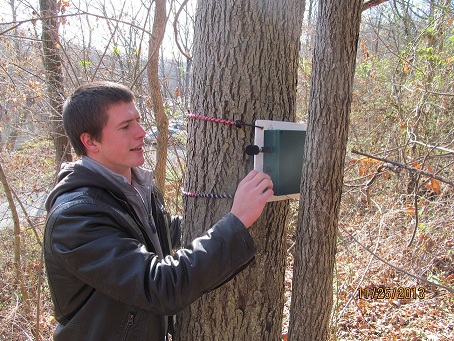
Incorporating Uncertainty into Recovery Goals for Endangered Species (Undergraduate Researcher Matt Zak)
The objective of this study was to evaluate the mention of uncertainty (i.e., variance) associated with population size estimates within U.S. recovery plans for endangered animals. To do this all finalized recovery plans were reviewed for listed terrestrial vertebrate species. It was found that more recent recovery plans reported more estimates of population size and uncertainty. Also, bird and mammal recovery plans reported more estimates of population size and uncertainty. It was recommended that updated recovery plans combine uncertainty of population size estimates with a minimum detectable difference to aid in successful recovery.
Fecal Testing, Baiting & White-tailed Deer (Undergraduate Researcher Teah Nauman Snyder)
The baiting and supplemental feeding of white-tailed deer has been used to help with nutrient deficiencies that may occur during the winter season in temperate areas and to help increase hunting success. However, many states in the U.S. have banned the practice of baiting for deer based on the philosophy of fair chase and potential spread of diseases. This experiment investigates the possibility that there are certain chemical signatures left in deer feces that could indicate the presence of an illegally baited site. Two populations of white-tailed deer were separated into control and experimental groups, with the experimental group exposed to Deer Cane® brand deer bait. Using a Chloride Ion Probe and Atomic Absorption Spectroscopy, we found no difference in chloride ion or sodium and calcium cation concentrations in white-tailed deer feces between the control and experimental deer populations. In addition, the use of Gas Chromatography-Mass Spectroscopy and Thin Layer Chromatography were not able to pick up the presence of Deer Cane® deer bait in deer feces.
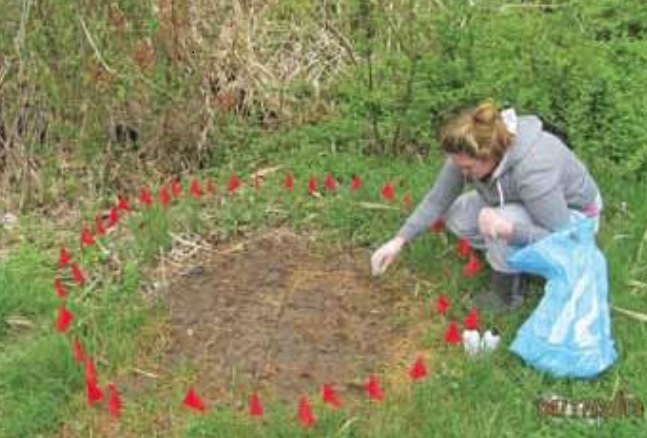
Urine Deer-based Lure Testing (Undergraduate Researcher Ken Strauser)
The Pennsylvania Game Commission contacted Millersville University to perform tests to help combat the transmission and spread of Chronic Wasting Disease (CWD) via better detection of urine-based deer lures. The objective of this study was to use multiple methods and kits for detection of urine and blood to determine the best method of detection for urine-based deer lures. Kits and methods included Uritrace®, Nite-SiteTM luminol, Hemascein® and Ultra-violet (UV) light. We found that no one technique showed a positive for all urine-based deer lures. The UV light and Uritrace methods were the most effective and the UV light was the best technique for the field. These findings are helpful in determining the best method to detect urine-based deer lures to help mitigate the spread of CWD.
